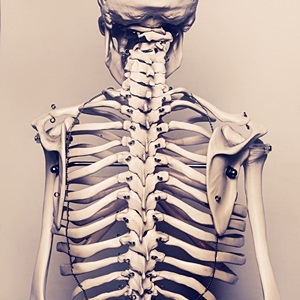
Belly fat, moles, anorexia, small testes, dowager's hump all have one thing in common – osteoporosis!
Yes, you read right. The mental image that comes to mind when thinking about osteoporosis is an elderly woman often struggling to maintain her posture.
However, some interesting facts have emerged when we strip away the clinical and cold literature and studies into osteoporosis defined as a systemic skeletal disease associated with decreased bone mass and quality, decreased muscle power and an increased tendency to fall.
1) Men get osteoporosis too
Lowered levels of testosterone usually in tandem with small testes are associated with age-related osteoporosis in men.
Men are the "weaker sex" in terms of death and disability caused by osteoporosis as their bone health is simply being ignored by health-care systems. A study from the USA has shown that men were 50% less likely to receive treatment than women.
It is estimated that the lifetime risk of experiencing an osteoporotic fracture in men over the age of 50 years is up to 27%, higher than that of developing prostate cancer, according to Professor John A. Kanis, who is president of International Osteoporosis Foundation.
Guys, read more about your osteoporosis risk here.
2) Belly fat
Belly fat puts women and men at risk for osteoporosis.
For years, it was believed that obese women were at lower risk for developing osteoporosis, and that excess body fat actually protected against bone loss.
A study found that having too much internal abdominal fat may, in fact, have a damaging effect on bone health.
Another study showed that visceral, or deep belly, obesity is a risk factor for bone loss and decreased bone strength in men.
"It is important for men to be aware that excess belly fat is not only a risk factor for heart disease and diabetes, it is also a risk factor for bone loss," said Miriam Bredella, MD, radiologist at Massachusetts General Hospital and associate professor of radiology at Harvard Medical School in Boston.
3) The dreaded dowager's hump
Osteoporotic changes most commonly affect the spine and hips. If you have osteoporosis of the spine, the vertebrae can fracture and this could see you getting a hunched back, otherwise known as dowager's hump.
There is no way of avoiding a hump from forming on your back, but you can reduce the chances of developing one by consuming the recommended daily allowance of calcium and vitamin D.
4) Many moles linked to lower risk of osteoporosis
If you have many moles, you may actually age slower than your "non-moley" friends, research suggests.
The slower rate of ageing in "moley" people could indicate that they will be less susceptible to age-related diseases such as osteoporosis although more research is needed to confirm this.
5) Anorexia
People who have suffered from an eating disorder, such as anorexia, are more prone to developing osteoporosis.
Your diet plays an integral role in both developing and treating osteoporosis also described at the “silent disease” because it progresses undetected for many years.
Insufficient intake or absorption of calcium and vitamin D results in bone loss.
Calcium is an essential mineral required for bone formation and is critical for bone health throughout one's life. If your daily intake of calcium is inadequate, the body takes what it needs from the bones, which may result in osteoporosis.
However, Calcium alone is not enough; be sure to take your vitamin D as well. The body needs vitamin D to absorb calcium. Without enough vitamin D, one can’t form enough of the hormone calcitriol (known as "active vitamin D").
This in turn leads to insufficient calcium absorption from the diet. In this situation, the body must take calcium from its stores in the skeleton, which weakens existing bone and prevents the formation of strong, new bone.
Read more:
Use this calcium calculator to check if your intake is adequate to prevent osteoporosis
South Africans underestimate men's osteoporosis risk
Risk factors for osteoporosis
Image: Structure of the human skeleton model by Shutterstock.




 Publications
Publications
 Partners
Partners











